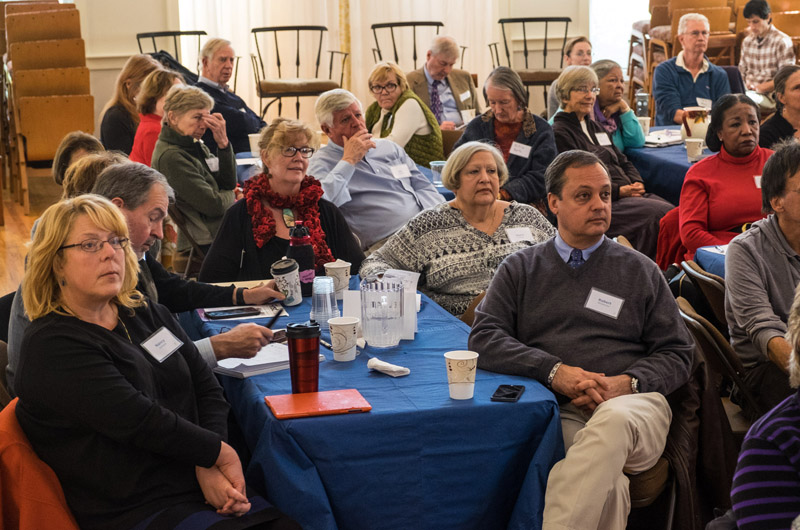A researcher for Brandeis University this week presented the first results of a major survey that will help set the course for Islandwide aging initiatives.
More than 80 people, most of them seniors themselves, sat around tables in the Martha’s Vineyard Hebrew Center for the presentation on Monday morning. Many stayed on for group discussions in the afternoon.
Susan Lanspery of the Heller School for Social Policy and Management at Brandeis, who is helping to analyze the results, reported a response rate of more than 40 per cent, with 1,955 surveys returned as of Nov. 23 and another 100 in the last two weeks.
“That is really amazing in such a short period of time,” she said.
A total of about 4,760 surveys were sent to every year-round senior residence on the Island in October. The 50 questions related to housing, employment, transportation and other topics that affect seniors and caregivers.
The results will help inform the work of the Healthy Aging Task Force, an Islandwide coalition of volunteers and organizations working to support Island seniors and caregivers. It may also provide a baseline for obtaining grants and funding in the future.
Peter Temple, acting director of the task force, introduced Ms. Lanspery on Monday and recalled the “roller coaster” ride of producing and distributing the survey. He acknowledged that the 50 questions could not cover all the issues facing seniors and expected similar surveys to be administered every few years.
Ms. Lanspery said most respondents had higher-than-average education levels compared to most people over 65 on the Island, and were somewhat younger and more affluent (only 25 per cent had annual incomes of less than $35,000).
In analyzing the results, however, researchers focused more on the answers of respondents with vulnerabilities associated with aging.
Among the highlights of the study, Ms. Lanspery pointed out that 45 per cent of respondents said they needed housing modifications such as hand rails and personal emergency systems, while 36 per cent lacked at least some of the resources needed to make those changes.
Only 13 per cent of respondents were employed full-time (21 per cent were employed part-time) and two per cent were seeking work. Of those working or seeking work, 26 per cent said they needed the income for their daily needs.
Some results came as a clear surprise.
Despite more than half of the respondents saying they participate often in community activities, almost three quarters said they never volunteer. That “struck us like a ton of bricks,” Ms. Lanspery said. Some people may be older with mobility issues, she added, but further study could reveal ways to increase volunteerism.
Slightly more than half of those aged 65 to 85 said they never made use of senior centers or councils on aging, while 37 per cent said they did occasionally. Those proportions flipped for people over 85, with 54 per cent saying they used such services occasionally and 28 per cent not at all.
Ms. Lanspery cautioned that the results were preliminary and also that many of the questions were subjective. Only one per cent of respondents rated their own overall health as poor, for example, with most choosing good or excellent. The same was true for mental health ratings. “We don’t want to put too much into this,” Ms. Lanspery said of the self-ratings. “[There are] lots of caveats.”
The most commonly cited health or wellness needs among respondents were home repair, yard work and heavy housekeeping. Meal preparation, managing medication and personal care were at the bottom of the list.
Twenty-seven per cent reported having fallen in the past year.
Ms. Lanspery drew attention to the fact that 16 per cent of respondents said they would have no help in emergencies, or were unsure whether they would or not; and 56 per cent said they had no one to help them in the long term.
At the same time, however, more than 90 per cent of people ages 65 to 85 did not want “friendly visits” or daily calls. More people over 85 were interested in those services, although a large majority were not.
Ms. Lanspery noted that many people are wary of strangers. Some respondents had even blacked out the bar codes on their surveys, she said, despite the survey stating that all responses were confidential.
The most frequently cited resources were senior centers and councils on aging (74 per cent), friends and family (67 per cent), visiting nurses or primary care physicians (51 per cent) and the Internet (36 per cent). Ms. Lanspery noted those numbers might change with the launching of First Stop, an Islandwide online resource, this week.
Throughout the presentation, audience members chimed in with questions and comments. Some noted the persistent need for affordable housing for both elders and caregivers. Others said that alcoholism and addiction are affecting old and young alike. One person pointed to the need for support in using new technology.
Another community presentation will accompany the final results in the new year.
For more information about the Healthy Aging Task Force, visit hatfmv.org.








Comments (1)
Comments
Comment policy »